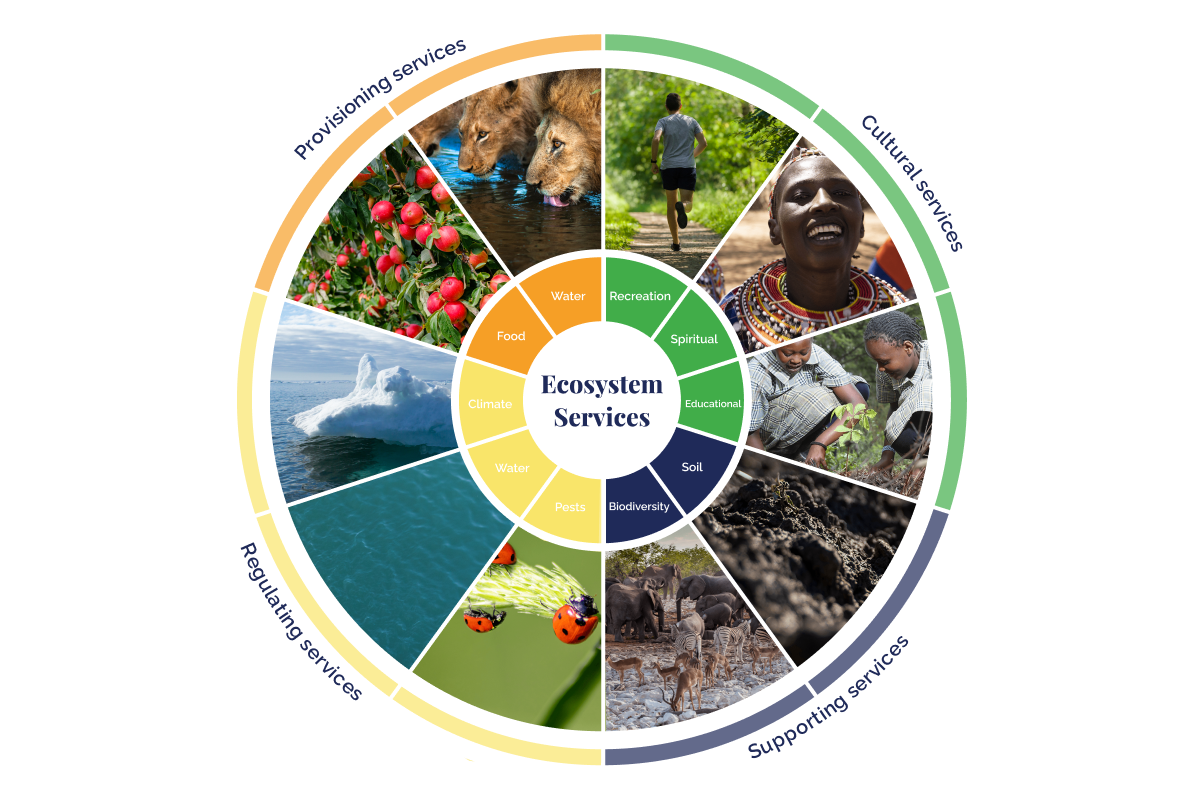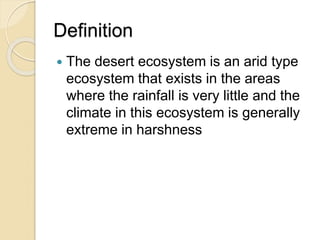Topic what is ecosystem service: Discover the indispensable role of ecosystem services, the natural benefits our planet provides, from clean air to fresh water, shaping the foundation for a sustainable and prosperous future for all.
Table of Content
- What are the four types of ecosystem services provided by nature?
- Definition and Importance of Ecosystem Services
- Types of Ecosystem Services
- Provisioning Services: Food, Water, and Raw Materials
- Regulating Services: Climate Regulation and Disease Control
- Cultural Services: Recreational, Spiritual, and Educational Benefits
- Supporting Services: Soil Formation and Nutrient Cycling
- YOUTUBE: Understanding Ecosystem Services
- Challenges and Opportunities in Ecosystem Service Conservation
- Impact of Human Activities on Ecosystem Services
- Strategies for Sustainable Management and Restoration of Ecosystem Services
- Case Studies: Successful Ecosystem Service Projects
- Future Directions in Ecosystem Service Research and Policy
What are the four types of ecosystem services provided by nature?
There are four types of ecosystem services provided by nature:
- Provisioning Services: These services include the production of food, water, and other resources that are directly harvested from ecosystems.
- Regulating Services: Natural processes that help regulate the environment, such as climate regulation, water purification, and disease control.
- Supporting Services: Services that are necessary for the production of all other ecosystem services, such as nutrient cycling, soil formation, and photosynthesis.
- Cultural Services: Non-material benefits that people obtain from ecosystems, including recreational, spiritual, and educational experiences.
READ MORE:
Definition and Importance of Ecosystem Services
Ecosystem services are the many and varied benefits that humans freely gain from the natural environment and from properly-functioning ecosystems. These include essentials such as clean air, water, and food, alongside regulation services like climate regulation, flood control, and disease prevention. Not only do they contribute to our well-being and economic prosperity, but they also play a critical role in supporting life by maintaining the balance and health of the Earth"s ecosystems.
- Provisioning Services: These are the products obtained from ecosystems, such as food, fresh water, wood, fiber, genetic resources, and medicines.
- Regulating Services: These services include climate regulation, disease control, water purification, and pollination, among others, that regulate environmental conditions.
- Cultural Services: Non-material benefits people obtain from ecosystems through spiritual enrichment, cognitive development, recreation, and aesthetic experiences.
- Supporting Services: Services such as soil formation, photosynthesis, nutrient cycling, and water cycling that underpin the production of all other ecosystem services.
The importance of ecosystem services cannot be overstated. They are foundational to the Earth’s life support systems and contribute significantly to human health, economic development, and the sustainability of our natural world. The preservation and enhancement of ecosystem services are therefore crucial for future generations.
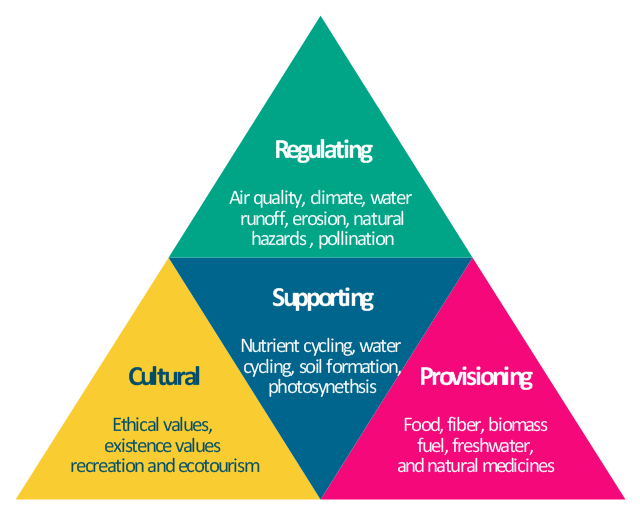
Types of Ecosystem Services
Ecosystem services, the life-sustaining benefits we receive from nature, are broadly categorized into four types, each vital to our survival and the health of the planet. Understanding these categories helps in appreciating the vast array of services nature provides and underscores the importance of conserving our natural environments.
- Provisioning Services: These are the products provided by ecosystems, including food (crops, seafood, game), water, timber, fiber, genetic resources, and medicinal resources. They are the most tangible benefits humans derive from the natural world.
- Regulating Services: These include benefits obtained from the regulation of ecosystem processes, such as air quality maintenance, climate regulation, water purification, erosion control, flood protection, and pollination. These services help mitigate environmental hazards and provide protection against natural disasters.
- Cultural Services: Non-material benefits obtained from ecosystems through spiritual enrichment, cultural experiences, leisure activities, and intellectual development. This category includes tourism, recreational activities, and the aesthetic inspiration derived from nature.
- Supporting Services: These are services that are necessary for the production of all other ecosystem services, including soil formation, photosynthesis, primary production, nutrient cycling, and water cycling. They support life"s foundation and ensure the continuity of conditions for life on Earth.
Each of these services plays a critical role in sustaining life by providing essential goods and services, regulating our environment, supporting the natural cycles and processes essential for life, and enriching our cultural, spiritual, and recreational lives.
Provisioning Services: Food, Water, and Raw Materials
Provisioning services are the products obtained from ecosystems, vital for human survival and economic activity. These services include the production of food, the provision of water, and the supply of raw materials, showcasing the direct benefits we derive from nature.
- Food: Ecosystems provide the conditions for growing crops, grazing livestock, and harvesting fish, shellfish, algae, and fungi. These food sources are essential for human nutrition and culinary traditions around the world.
- Water: Freshwater services are crucial for drinking, irrigation, sanitation, and industrial processes. Ecosystems regulate the water cycle, ensuring the availability of water for various human uses.
- Raw Materials: Forests, wetlands, and marine ecosystems supply timber, fibers, biofuels, and other materials for construction, clothing, medicine, and crafts. These resources are the foundation of many industries and traditional practices.
These provisioning services are not only fundamental for survival but also underpin economies worldwide. Sustainable management and conservation of ecosystems are essential to ensure the continued availability of these critical resources for future generations.
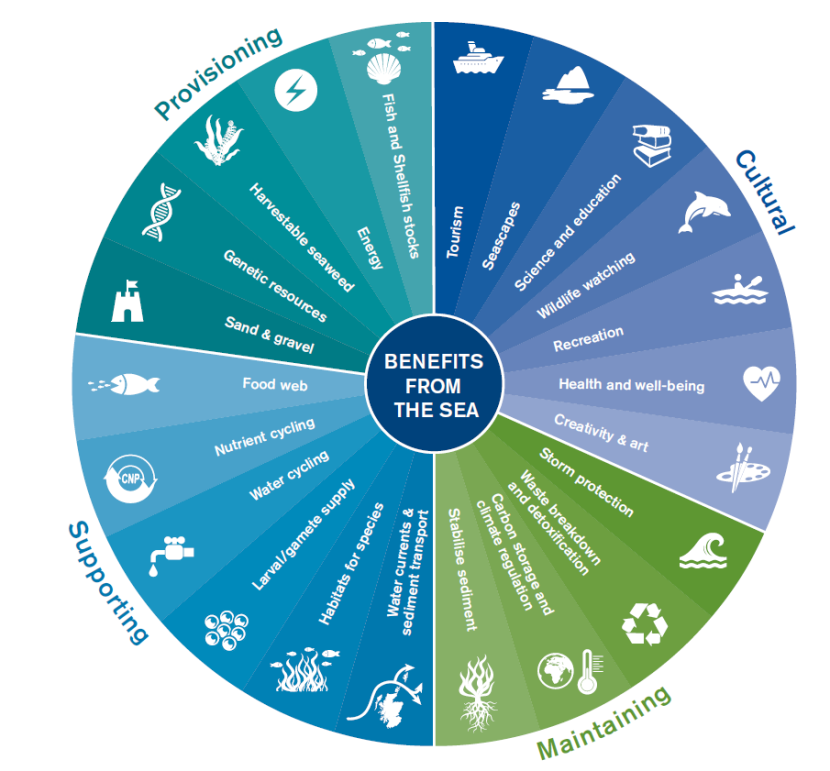
Regulating Services: Climate Regulation and Disease Control
Regulating services are critical ecosystem functions that maintain the balance of the natural world, directly impacting human well-being and environmental health. These services include climate regulation and disease control, among others, playing a pivotal role in stabilizing the global and local climates and reducing the spread of diseases.
- Climate Regulation: Ecosystems regulate the Earth"s climate through carbon sequestration and storage, influencing both global and local weather patterns. Forests, oceans, peatlands, and other ecosystems absorb CO2, helping to mitigate the effects of climate change. Additionally, vegetation cover and wetlands regulate temperature, humidity, and rainfall, contributing to favorable climatic conditions for human habitation and agriculture.
- Disease Control: Healthy ecosystems contribute to disease control by supporting a variety of species that help regulate populations of pests and disease vectors. For example, wetlands filter pollutants and reduce the prevalence of waterborne pathogens, while diverse ecosystems can disrupt the transmission cycles of infectious diseases, reducing their spread to humans and other animals.
The preservation and enhancement of regulating services are crucial for preventing the adverse effects of climate change and minimizing the risk of disease outbreaks. Effective management and conservation strategies for ecosystems are therefore essential for maintaining these vital services.
Cultural Services: Recreational, Spiritual, and Educational Benefits
Cultural services provided by ecosystems offer non-material benefits that enrich human life, fostering well-being, and contributing to cultural, recreational, spiritual, and educational experiences. These services highlight the intrinsic value of nature, connecting us to our heritage and providing essential opportunities for learning and leisure.
- Recreational Benefits: Natural landscapes and water bodies provide spaces for leisure activities such as hiking, birdwatching, fishing, and camping. These activities not only support physical health but also mental well-being by offering relaxation and a break from urban environments.
- Spiritual and Religious Significance: Many cultures and religions attribute sacred values to natural sites and species, finding spiritual solace and inspiration in the natural world. Forests, rivers, mountains, and other natural elements play a central role in spiritual practices and rituals.
- Educational Value: Ecosystems are living laboratories for education and research, offering invaluable opportunities for learning about biology, ecology, and environmental science. Outdoor educational programs in natural settings enhance learning experiences and foster a greater appreciation for the environment.
- Aesthetic Appreciation: The beauty of natural landscapes inspires art, folklore, national pride, and a sense of place. Aesthetic appreciation of nature contributes to our mental health and encourages conservation efforts.
The protection and sustainable management of ecosystems are vital to preserving these cultural services, ensuring that future generations can continue to enjoy and learn from the natural world.
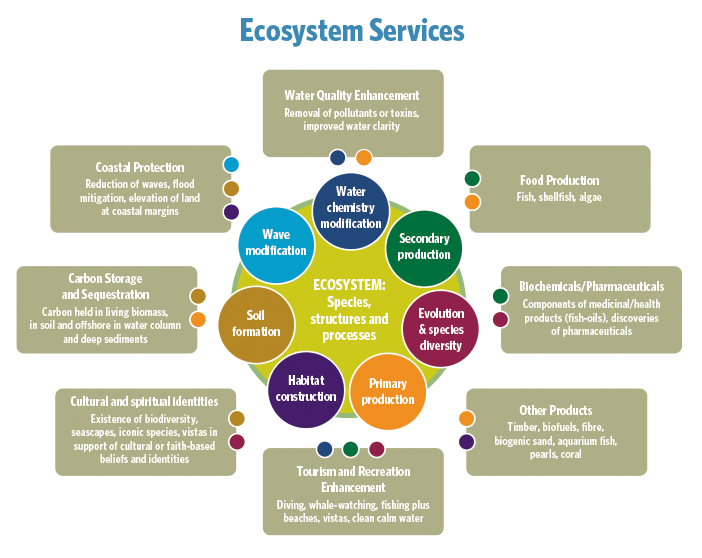
Supporting Services: Soil Formation and Nutrient Cycling
Supporting services are fundamental ecosystem processes that underpin the production of all other ecosystem services, enabling the Earth to sustain life. Soil formation and nutrient cycling are key components of these services, essential for the health of the planet and the well-being of its inhabitants.
- Soil Formation: The process of soil formation, or pedogenesis, involves the weathering of rock and the decomposition of organic matter, creating the upper layer of the Earth"s crust that supports plant life. This fertile ground is crucial for agriculture, forestry, and natural vegetation, providing the basis for food production and terrestrial ecosystems.
- Nutrient Cycling: Nutrient cycling is the movement and exchange of organic and inorganic matter back into the production of living matter. It includes the carbon, nitrogen, phosphorus, and water cycles, among others. These cycles ensure the availability of essential nutrients in forms that plants and animals can assimilate, supporting a vast array of ecosystem functions and services.
Without these supporting services, ecosystems would not be able to provide food, regulate water, or sustain biodiversity. The maintenance of soil health and the balance of nutrient cycles are therefore critical for the resilience of ecosystems and the services they provide to humanity.
Understanding Ecosystem Services
Dive into the enchanting world of biodiversity and witness the beauty of various species coexisting in harmony. Discover the incredible diversity of life on Earth in this captivating video that celebrates nature\'s wonders.
Ecosystem Services
Embark on a journey of conservation and learn about the efforts being made to protect our planet\'s precious ecosystems and wildlife. Be inspired by the stories of resilience and hope as dedicated individuals work tirelessly to preserve the natural world for generations to come.
Challenges and Opportunities in Ecosystem Service Conservation
Conserving ecosystem services presents both significant challenges and unique opportunities. Addressing these challenges requires innovative approaches, collaborative efforts, and a commitment to sustainable practices that ensure the long-term health and resilience of ecosystems worldwide.
- Challenges:
- Increasing pressure from land development, agriculture, and natural resource exploitation, leading to habitat loss and degradation.
- Climate change impacts, such as altered weather patterns and increased frequency of extreme events, disrupting ecosystem balance.
- Pollution from industrial, agricultural, and urban sources, affecting air, water, and soil quality.
- Overexploitation of resources, including overfishing, deforestation, and unsustainable water use, threatening biodiversity and ecosystem functions.
- Opportunities:
- Adopting integrated management approaches that consider ecological, social, and economic factors to sustainably manage and restore ecosystems.
- Enhancing biodiversity conservation efforts to strengthen ecosystem resilience and functionality.
- Investing in green infrastructure and nature-based solutions to address urban and rural environmental challenges.
- Fostering global and local partnerships among governments, private sector, communities, and non-governmental organizations to share knowledge, resources, and best practices.
- Advancing research and innovation in ecosystem science, monitoring, and technology to better understand, protect, and utilize ecosystem services.
The path to conserving ecosystem services lies in recognizing their value, understanding the threats they face, and harnessing the opportunities for sustainable management and restoration. Through concerted efforts, it is possible to ensure these vital services continue to support life on Earth for generations to come.
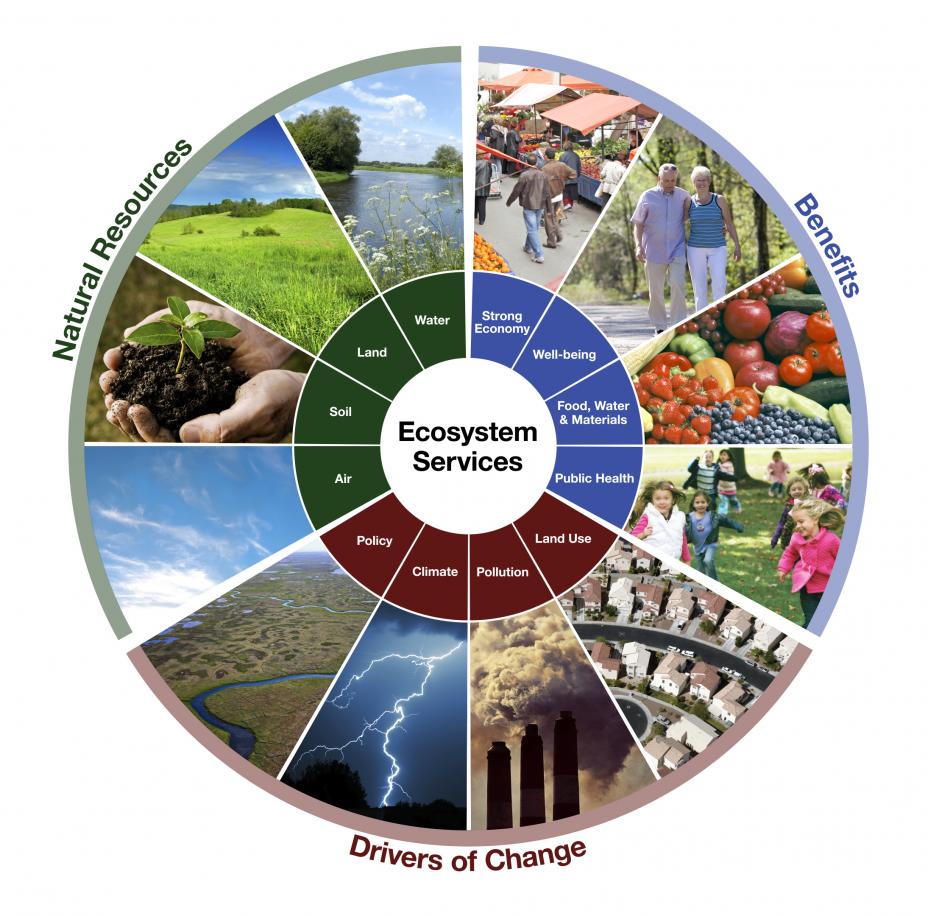
Impact of Human Activities on Ecosystem Services
Human activities have a profound impact on ecosystem services, affecting their capacity to support life and human well-being. While some activities can have positive effects, many lead to degradation and loss of vital services. Understanding these impacts is crucial for developing strategies to mitigate negative consequences and enhance ecosystem resilience.
- Land Use Change: Urbanization, agriculture expansion, and deforestation alter land cover, reducing biodiversity and the ability of ecosystems to provide services such as carbon sequestration, water purification, and soil stabilization.
- Pollution: Air, water, and soil pollution from industrial processes, agriculture, and waste disposal disrupt ecosystems, impairing their ability to deliver clean air, water, and healthy soils.
- Climate Change: Increased greenhouse gas emissions from human activities contribute to climate change, affecting weather patterns, sea levels, and climate regulation services provided by ecosystems.
- Overexploitation: Overfishing, unsustainable water use, and extraction of natural resources exceed the regenerative capacity of ecosystems, leading to diminished provisioning services like fresh water, food, and raw materials.
- Invasive Species: The introduction of non-native species can disrupt local ecosystems, leading to loss of native biodiversity and alteration of ecosystem functions and services.
Addressing the impact of human activities on ecosystem services requires concerted global and local actions, including sustainable management practices, restoration efforts, and policies that promote conservation and sustainable use of natural resources. By taking steps to reduce negative impacts, we can ensure the continued provision of these essential services for future generations.
Strategies for Sustainable Management and Restoration of Ecosystem Services
Sustainable management and restoration of ecosystem services are crucial for ensuring the health and resilience of our planet"s ecosystems. Implementing effective strategies can help reverse the degradation of ecosystems, ensuring they continue to provide essential services for future generations. Here are key strategies for achieving this goal:
- Integrated Land and Water Management: Adopting practices that consider the interconnectivity between land, water, and ecosystems to manage resources holistically, enhancing biodiversity, water quality, and land productivity.
- Conservation and Protected Areas: Establishing and effectively managing protected areas to conserve biodiversity and ecosystem services, including marine reserves, national parks, and wildlife sanctuaries.
- Restoration of Degraded Ecosystems: Implementing restoration projects to rehabilitate degraded lands, forests, wetlands, and coastal ecosystems, enhancing their capacity to provide ecosystem services.
- Sustainable Agriculture and Forestry Practices: Promoting practices that increase productivity without degrading the land, such as agroforestry, conservation tillage, and organic farming, to maintain ecosystem services.
- Ecosystem-based Adaptation: Utilizing natural solutions to address climate change impacts, such as planting mangroves to protect shorelines from erosion and using green infrastructure to manage urban flood risks.
- Community Engagement and Indigenous Knowledge: Involving local communities and indigenous peoples in conservation efforts, recognizing their traditional knowledge and practices in ecosystem management.
- Policy and Incentive Mechanisms: Developing policies and incentives that encourage sustainable use and restoration of ecosystems, including payment for ecosystem services, environmental regulations, and green certification schemes.
By implementing these strategies, we can create a sustainable future where ecosystems continue to thrive and provide the essential services upon which all life depends.

Case Studies: Successful Ecosystem Service Projects
Examining successful ecosystem service projects provides valuable insights into effective conservation and restoration practices. These case studies demonstrate the positive impact of sustainable management on ecosystems and the services they provide to communities worldwide.
- Reforestation in Costa Rica: Costa Rica"s national payment for ecosystem services program has successfully reversed deforestation rates, enhancing biodiversity, carbon sequestration, and water regulation services through financial incentives for forest conservation and reforestation.
- Wetlands Restoration in the United States: The restoration of the Florida Everglades represents one of the most significant efforts to restore a degraded wetland ecosystem, improving water quality, increasing biodiversity, and enhancing flood protection services.
- Sustainable Agriculture in Kenya: The introduction of sustainable farming practices in the Tana River Basin has improved soil health, increased agricultural productivity, and provided better food security while preserving ecosystem services.
- Mangrove Restoration in Vietnam: The planting of mangroves along Vietnam"s coastline has protected communities from typhoons and flooding, while also improving fisheries and supporting biodiversity.
- Urban Green Spaces in Singapore: Singapore"s integration of green spaces into urban planning, including the development of parks and green roofs, has enhanced air and water quality, provided recreational opportunities, and supported urban biodiversity.
These case studies highlight the diverse approaches and benefits of ecosystem service projects, showcasing how targeted actions can restore and enhance the natural environment for the benefit of both nature and humanity.
READ MORE:
Future Directions in Ecosystem Service Research and Policy
The future of ecosystem service research and policy is poised for significant advancements, focusing on integration, innovation, and sustainability. As the importance of ecosystem services becomes increasingly recognized, the next steps involve deepening our understanding and enhancing the policies that protect these vital resources.
- Integrated Assessment Models: Developing sophisticated models that can accurately predict the impacts of human actions on ecosystem services, aiding in the creation of more effective conservation strategies.
- Valuation of Ecosystem Services: Improving methods for valuing ecosystem services in economic terms to better inform policy and investment decisions, ensuring that the benefits of ecosystems are fully recognized in development planning.
- Policy Integration: Ensuring that ecosystem services are integrated into all relevant policy areas, including urban planning, agriculture, water management, and climate change mitigation, to support holistic and sustainable development.
- Participatory Management Approaches: Engaging local communities, indigenous peoples, and other stakeholders in the management of ecosystems to harness local knowledge and ensure that conservation efforts are culturally appropriate and supported by those who are most affected.
- Technological Innovations: Leveraging technology, including remote sensing, big data, and blockchain, to monitor ecosystem services, enforce environmental regulations, and promote transparency in the use of natural resources.
- Global Cooperation: Strengthening international collaboration to address transboundary environmental issues, share best practices, and support global initiatives aimed at conserving and restoring ecosystems.
By focusing on these future directions, researchers and policymakers can work together to ensure that ecosystem services continue to sustain life on Earth, supporting biodiversity, human well-being, and economic development for generations to come.
Embracing ecosystem services as vital to our survival ensures a sustainable future, inviting us all to contribute to the preservation and restoration of our planet"s invaluable natural gifts for generations to come.
